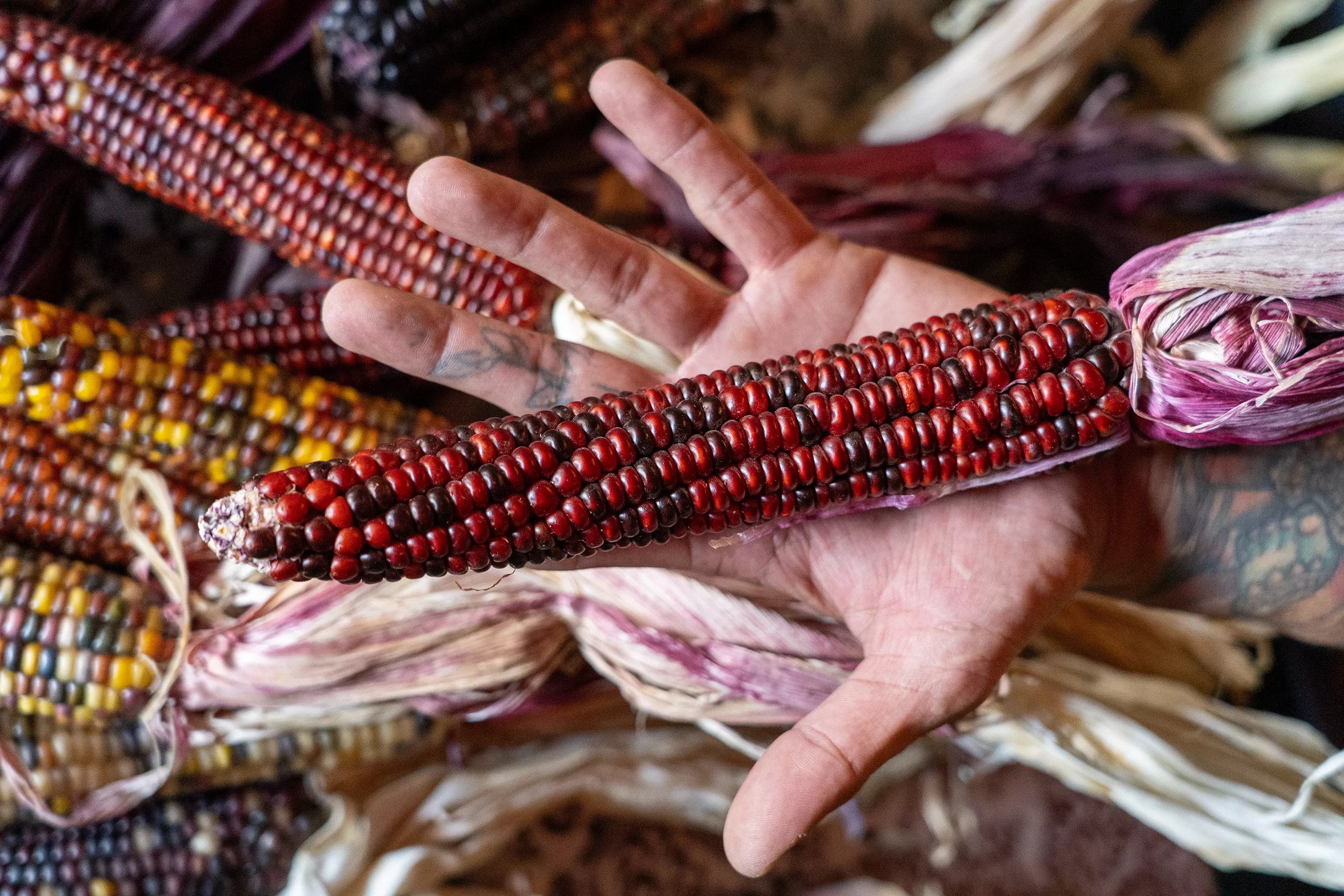
Philip Poston

Audio By Carbonatix
An exciting dining revolution is happening: At Mexican restaurants across Denver, renowned chefs and culinary innovators are placing heirloom corn and its ancestral preparation practices at the heart of their modern menus.
“There’s so much you can do with corn,” says Johnny Curiel, executive chef of Denver’s newest Michelin star restaurant, Alma Fonda Fina, and its sister concept, Cozobi Fonda Fina in Boulder. “And that’s why, whenever we change our menus, we focus on our masa section. I want to be able to bring a guest back to Mexico by a bite.”
Curiel’s approach is part of an exciting dining revolution in Denver and beyond as chefs and culinary innovators place heirloom corn and its ancestral preparation practices at the heart of their menus. Set against the backdrop of a modern world preoccupied with convenience and fashionable trends, the importance of preserving and perpetuating traditional food practices like nixtamalization becomes more crucial with each passing day.
Nixtamalization is the chemical process of placing raw corn kernels (maiz) in a water-alkaline solution (cal) and boiling it to break down the kernel’s outer skin, allowing access to its nutrients during digestion. That cal water is drained off and the maiz is ground in a milling machine (molino) resulting in a dense corn paste (masa). Maiz’s various hues of reds, blues, oranges and yellows come from its chemical makeup, providing different nutritional aspects and, equally important, different textures and flavors.
This year, make your gift count –
Invest in local news that matters.
Our work is funded by readers like you who make voluntary gifts because they value our work and want to see it continue. Make a contribution today to help us reach our $50,000 goal!
The Spanish saying “Sin maíz, no hay país” translates to English as, “Without corn, there is no country.” It is a declaration of maiz’s immense influence on Mexican society and its history.
Originally from Guadalajara, Curiel wanted to share this aspect of his Mexican heritage with his cooks who don’t have a firsthand connection to maiz. “They don’t know the history of nixtamal. They don’t understand that to us, it is the backbone of our cuisine. Sin maíz, no hay país. That’s really what it is.”
Curiel’s passion for maiz is shared by others in the local food scene, and we talked with some of them about the personal and profound reasons behind the rise of maiz in Denver’s dining landscape.
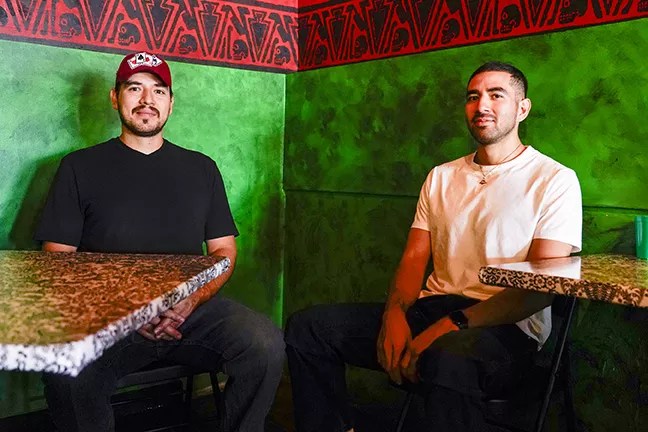
Alejandro and Alberto Rodriguez are the brothers behind Dos Caras Molino.
Philip Poston
Alejandro and Alberto Rodriguez, Dos Caras Molino
comidadoscaras.com
Since launching Dos Caras Molino in 2011, brothers Alberto and Alejandro Rodriguez have been making salsa macha and masa, leading nixtamal classes and running a food pop-up, all while advocating for masa and maiz from outside the restaurant industry.
Alejandro sees the growing presence of maiz not just as masa having a moment, but rather as the opening scene of a new era for chefs to step into the spotlight and bring their backstory to the menu – a tale that is inextricably connected to maiz for Mexican Americans.
“I think that in this restaurant industry, especially here in Denver, chefs are now given the opportunity to expand on their backgrounds,” Alejandro notes. “These guys were working in the industry before, working with well-known chefs, and now they have the opportunity to do their own concepts. I think they’re also filling this gap in the market where people want better-quality Mexican food. They’re doing cool stuff that’s putting maiz on the forefront.”
Dos Caras showcases different maiz types by working directly with regional producers like Bow & Arrow – a brand from the Ute Mountain tribe in Colorado’s Four Corners region. With new nixtamal-centric concepts like Alma Fonda Fina, Xiquita and La Diabla, Alejandro feels that maiz is finally being approached with the attention it deserves. “It’s being highlighted now with the proper producers,” he says. “The process isn’t changing; it’s just done correctly now versus buying something that’s super cheap. We’ve been given the opportunity to get our molino up and running to create this product that we feel is a little bit more representative of maiz.”
However, Alejandro adds, more education is needed to fill the knowledge gap he sees in local consumers about how to nixtamalize and properly utilize masa. “When you cook, you’re kind of disseminating your own culture through food, through your experiences, something that we should all be doing. That’s why I have that desire to teach people,” he explains. “You’re giving them some education and some power to re-create the flavor memories that they’re looking for.”
Alejandro and Alberto hand-press 250 tortillas a week while dishing up creative spins on sentimental flavors wherever their weekly itinerary has them popping up.
“It’s a little taste of home every single time we do a specific recipe,” Alberto says. “It tastes like your childhood; it tastes like holidays; it tastes like going back to Mexico. We are a molino first and foremost, selling people tortillas and the value of that. It is a lot of time. From the nixtamal all the way to the package, they see it is a labor of love.”

Johhny Curiel serves food at the chef’s counter inside Alma Fonda Fina.
Shawn Campbell
Johnny Curiel, Alma Fonda Fina and Cozobi Fonda Fina
almalohidenver.com
cozobifondafina.com
Every time Johnny Curiel places a maiz order for Alma Fonda Fina, ten different types arrive at his restaurant from Masienda Masa Company. He has a staff position tasked solely with nixtamalization, milling, pressing and baking the masa for the 500 tortillas the restaurant sells nightly. Dos Caras, Alma Fonda Fina and another newcomer, Xiquita, also use molinos made by Masienda, a ten-year-old company credited for disrupting the global corporate masa monopoly and working directly with local growers in Mexico to create greater accessibility to quality masa and its machinery.
Curiel estimates that attention to these various details costs him about $100,000 a year. It is a huge expense, but in the name of masa, he was not deterred. “At the end of the day, to me and to my wife, Kasie, it was more important to share our story and to say, ‘This is what Mexico is,'” he says. “We buy from different regions so you can taste and see and feel different corn. Every one soaks up moisture differently. Every one takes the color in a different way – the way the tortilla feels, the weight, how long you cook it. That’s what I love about nixtamal.”
Curiel’s reasons for centering traditional techiques are less about controlling the moment and more about setting a course for the future. “I want to make sure that I can continue those traditions – not because of me, but because of all the other people. So maybe, hopefully, today, tomorrow or ten years from now, if one of them opens a restaurant, they’ll say, ‘We’re not buying masa, we’re making nixtamal.'”
The ubiquitous taco has been the longtime touchstone for American diners to Mexican corn, Curiel adds, but Alma Fonda Fina’s and Cozobi’s menus are intended to enlighten guests to the complexity of maiz, which is the truest portal to Mexico’s core flavor zone. It is grown throughout the country in countless varieties and has been consumed in essentially every home at every meal for thousands of years.
“There are layers to everything,” Curiel says. “I always think that it’s important because we can take for granted something that’s so important to Mexican cuisine, which is corn. We would not be who we are today if it wasn’t for corn.”

“It is imperative for us who do nixtamalization that we use good-quality corn,” says Jose Avila.
Philip Poston
Jose Avila, La Diabla
ladiabladenver.com
After a couple of decades cooking in Denver kitchens and overseeing a few well-known Mexican concepts, Jose Avila has had maiz on his mind longer than most chefs in town. “The biggest challenge when I started to do the nixtamal process back in 2011 was to source good corn at the time. This is also why I started to grow my own corn in Pueblo, so I can have more control on the quality and the pricing,” he notes.
Since then, Avila has seen a swelling interest in masa in Denver, mostly in the form of tortillas and tamales. But he also knew of the plethora of ways that masa can be pressed, pinched and patted into memelas, sopes and huaraches – esoteric terms in the U.S., but commonplace in the Mexico City markets where he trolled as a kid at his grandma’s elbow.
On school field trips, a young Avila visited museums with illuminated Aztec relics and began to understand the link between history and food. Now, as an experienced chef, he embraces that wider presence of quality maiz and masa in the marketplace.
“I think it’s great,” he exclaims. “It’s been a long time coming for the community here in Denver. There are 300 varieties of 64 breeds of corn that we can choose to play with. There’s a lot more than Olathe corn, and we are seeing and tasting that on menus across Colorado.”
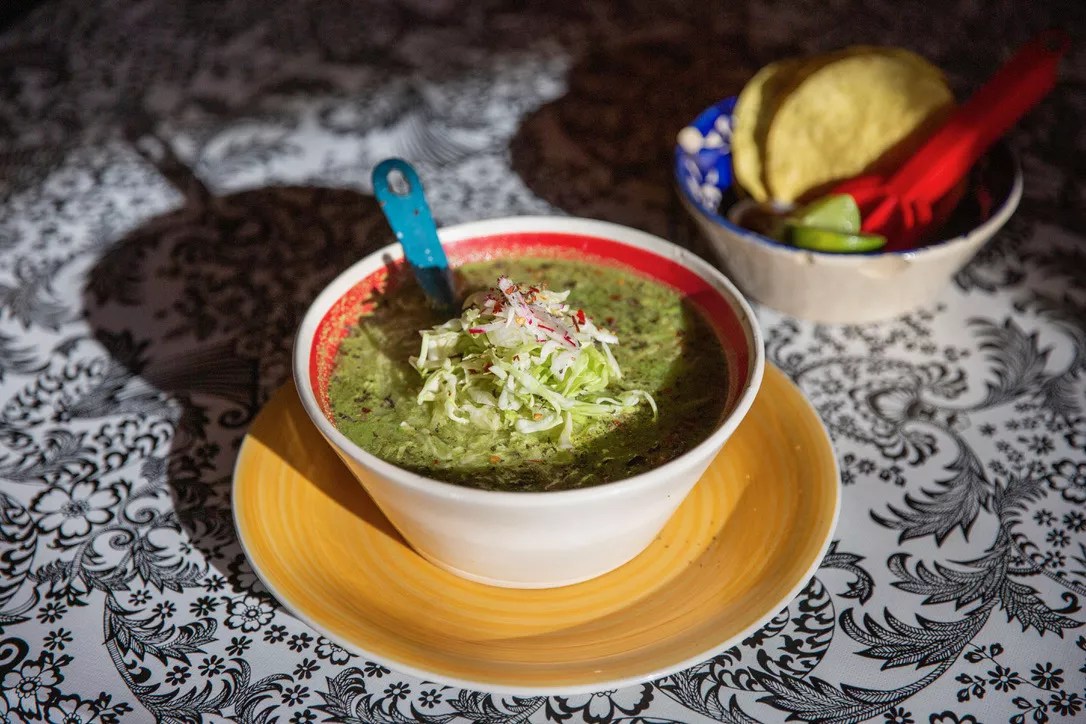
La Diabla’s pozole verde.
Photo courtesy of La Diabla
But Avila saw the absence of something else: pozole, with its complex flavors and Indigenous ingredients, simmered into a concentrated centuries-old broth. Avila knew that pozole required nixtamalized maiz, but after that, it goes right into the soup rather than the molino for masa. It was an untapped platform to showcase his deep appreciation for maiz, and in 2021, he launched his own powerhouse restaurant, La Diabla, with a tight focus on pozole and handmade masa.
“Sin maíz, no hay país. It’s a great rhyme and makes for a cool T-shirt, but unfortunately, the reality is that a big part of the tortillerias in Mexico use low-quality corn, which makes a low-quality masa,” Avila notes. “It is imperative for us who do nixtamalization that we use good-quality corn and follow those techniques from the Nahuas from the thirteenth century and to continue to promote it for future generations – especially pozole, which is the oldest dish that we can eat nowadays. That’s pretty badass!”
Avila is a dark romantic, nostalgic for those ancient Aztec human sacrifices associated with pozole ceremonies. But he’s also pragmatic, cultivating three specific varieties of maiz: cacahuazintle for pozole, and bolita azul and xocoyul rosa for the masa tortillas, huaraches and gorditas on La Diabla’s highly acclaimed menu.
“This food is a great way to represent where I’m from, especially being in a different country. It is our flesh, our bones. This is what corn meant to the Nahuas, and as Mexicans, this is our DNA.”
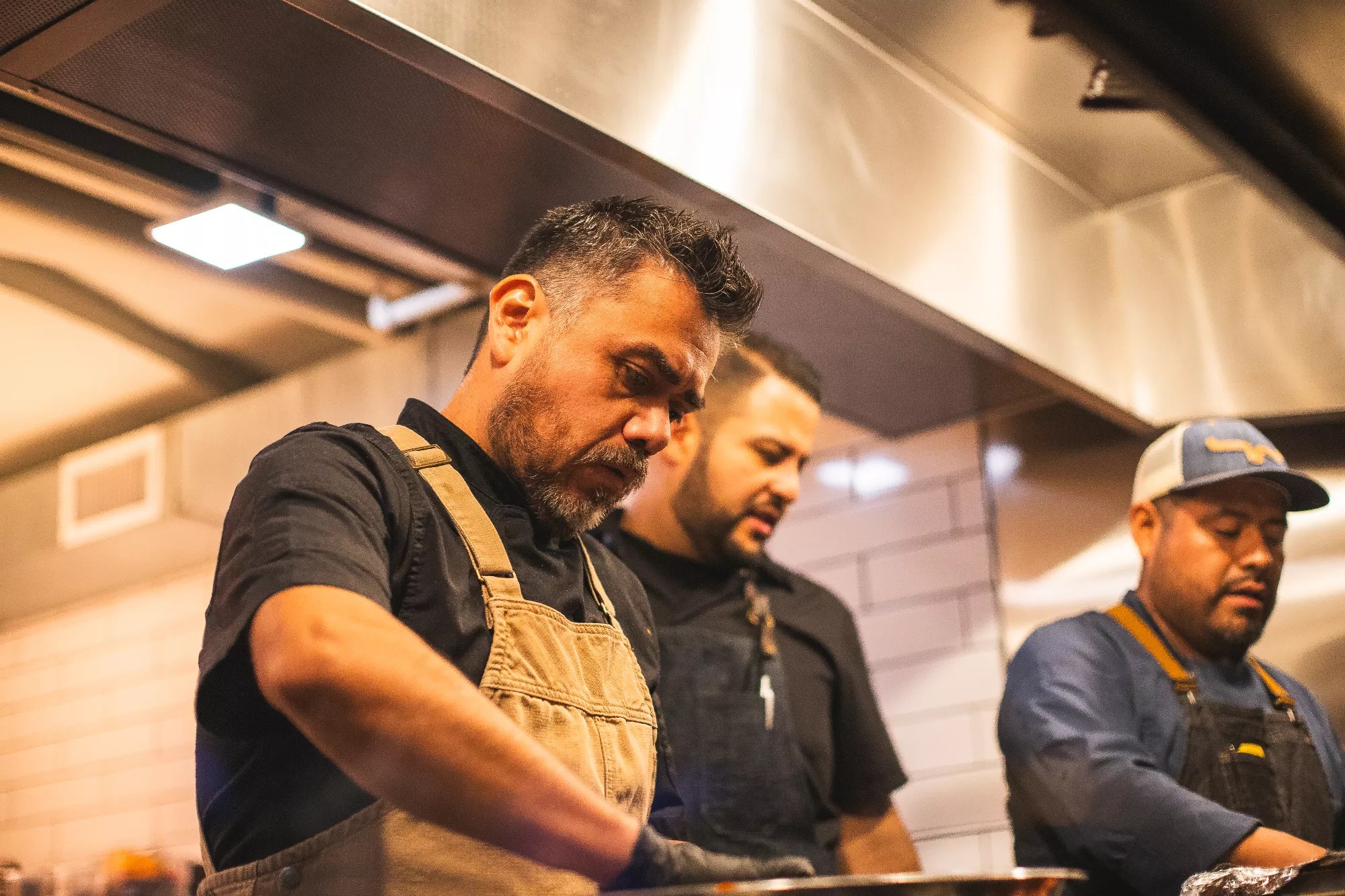
Rene Gonzalez Mendez uses masa in a variety of ways at Xiquita.
Casey Wilson
Rene Gonzalez Mendez, Xiquita
xiquita.co
In August, the team behind Park Hill pan-Latin restaurant Lucina added a sister concept in Uptown, Xiquita, which is headed up by chef and owner Erasmo “Ras” Casiano and executive chef Rene Gonzalez Mendez, and has an entire menu section dedicated to masa.
Gonzalez Mendez feels that the current players in Denver’s Mexican food scene have brought the category to previously unobtained heights of expression and excellence – but he also thinks the cuisine still has the potential to take diners deeper and raise their appreciation higher.
“I believe that chefs and cooks want to educate the community and show that Mexican cuisine is not only made up of guacamole and salsas, but also holds great value and complexity. The challenges are getting people to learn, try and see that Mexican cuisine is not just enchiladas and tacos,” he notes. “The reward is meeting people and creating a circle of friends based on our table of food.”
Xiquita’s table is covered with dishes like tlacoyos, tetelas, huachinango and sopes, working with Colorado-based providers like Bow & Arrow to curate the maiz for their masa plates. It has devoted a specific area by the dining room to cooking masa moments before it is plated. Most diners would be forgiven for not knowing how to pronounce most of these dishes or even what they are. But that moment where curiosity meets cultural cuisine is where you’ll find these chefs.
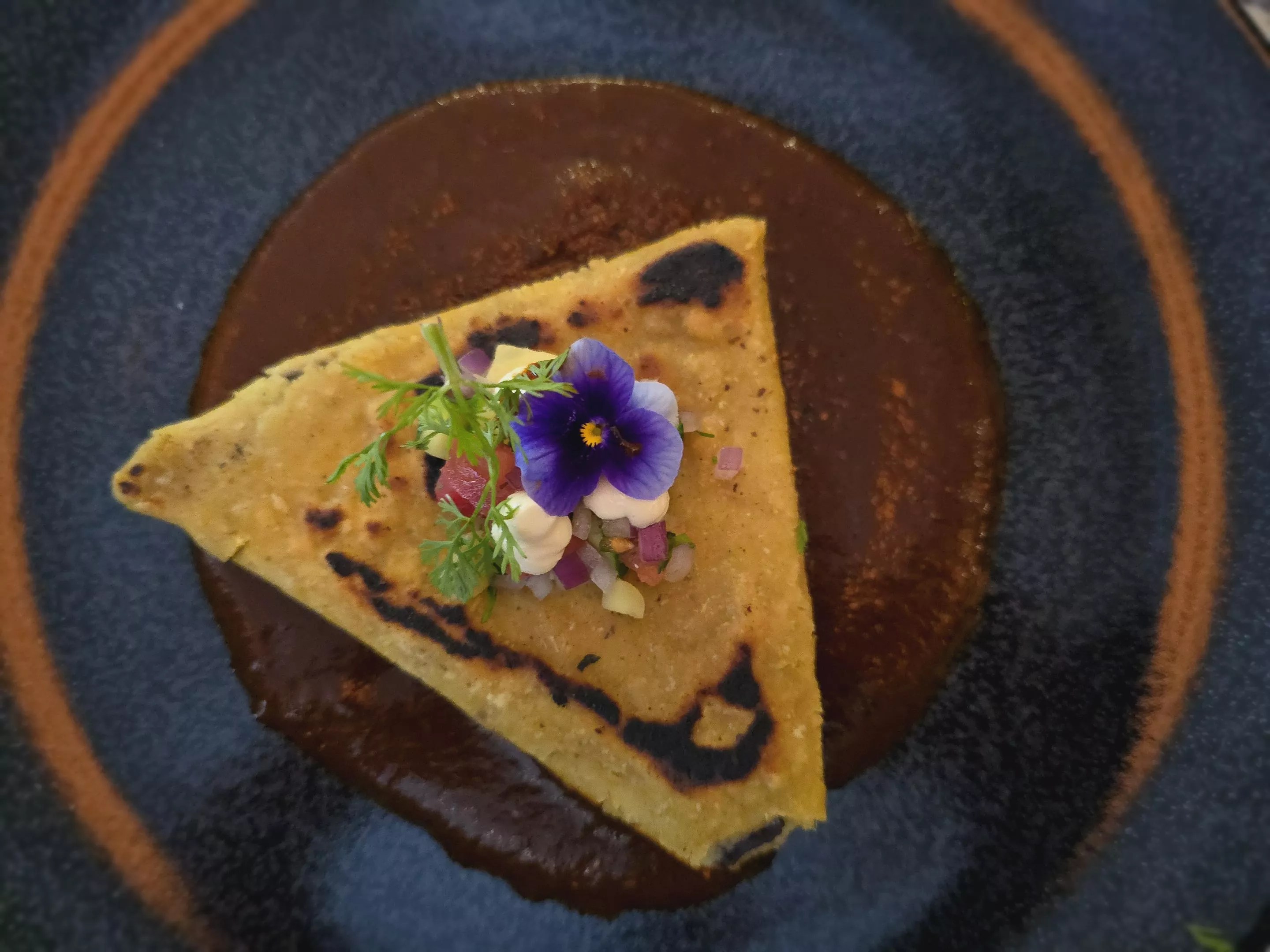
The tetela at Xiquita.
Molly Martin
“The idea is to showcase the great versatility of our star product. People should know that nixtamalized masa can be used for more than just one purpose,” Gonzalez Mendez says. “In every dish on our menu, we use the masa in different ways, giving each dish a unique texture.”
The influence of, and interest in, ancestral Mexican cooking has spread around the entire world in recent years, from highly celebrated masa-based taquerias like Breddos in Oslo and Hija de Sanchez in Copenhagen to the freshly opened Komal molino in Los Angeles and the blooming list of restaurants here in Denver.
The future of maiz, masa and the molino lies at the precarious intersection of preserving ancestral food practices and facing modern-day challenges. But there are also scores of supporters in this effort – vendors striving to provide the finest raw goods, eager patrons filling dining rooms, and chefs determined to not sacrifice quality for convenience. Within this network, we are all colleagues and collaborators, working together in this journey from maiz to menu and relishing in what we find.
“Mexico has a vast cultural diversity,” Gonzalez Mendez concludes. “For me, as a Mexican chef, it is a pleasure to display all our efforts to preserve our food and pass it on not only to our children, but also to our Latino and American communities. ‘Preservation’ is the word that defines Mexican cuisine.”